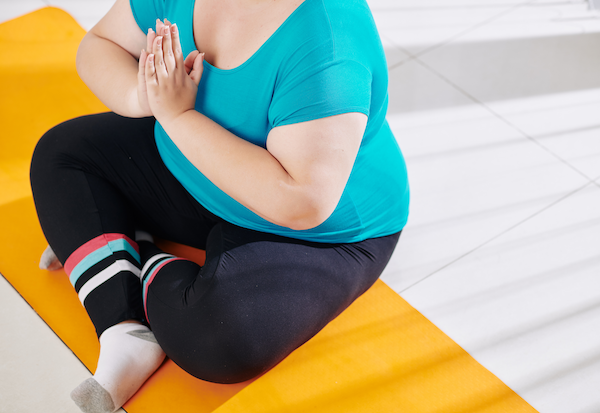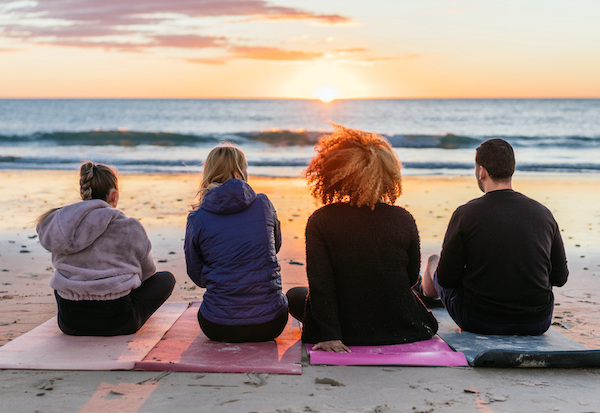
Yoga is an excellent form of exercise that offers numerous physical, mental, and emotional benefits. As an overweight beginner, you might feel intimidated by the idea of starting a yoga practice, but rest assured that yoga is for everyone, regardless of body shape or size. With the right approach and a supportive environment, yoga can become a valuable and enjoyable part of your fitness journey.
When it comes to yoga for overweight beginners, it’s essential to choose a style that suits your personality, goals, and abilities. There is a range of yoga styles available, including gentle Hatha, Kripalu, Viniyoga, and Integral yoga, which are suitable for beginners and can be adapted to accommodate different body types. These styles emphasize proper alignment, breath control, and mindful movement, allowing you to develop flexibility, strength, and stress relief at your own pace.
In addition to selecting an appropriate yoga style, it’s crucial to find a supportive and welcoming environment for your practice. This could be a dedicated class for larger bodies or simply a beginner’s course with a teacher who is experienced in working with diverse abilities and body sizes. Remember that yoga is a journey of self-discovery and self-improvement, so be patient with yourself and celebrate your progress along the way.
Table of Contents
Why Do Yoga?
Yoga can offer numerous benefits to individuals of all sizes, including those who are overweight. Firstly, it can help you lose weight by offering a low-impact workout that burns calories and tones your body. With consistent practice, you may observe gradual weight loss and increased muscle strength.
Another benefit of yoga is its ability to reduce stress and cortisol levels, which are often linked to weight gain. By decreasing anxiety and depression, and improving sleep, yoga helps you stay emotionally balanced, making it easier for you to make healthier choices when it comes to your diet and overall well-being.
Furthermore, yoga is excellent for building flexibility and balance, which are essential for preventing injuries and improving overall body function. Regardless of your weight, practicing yoga regularly can lead to increased mobility and a reduction in body aches. This, in turn, can make it easier for you to engage in other forms of physical activity in your daily life.
In addition to physical benefits, yoga also encourages mindfulness and self-awareness. As you focus on your breath and movements, you’ll develop a stronger connection between your mind and body. This increased self-awareness may help you make healthier choices, both mentally and physically, that contribute to your overall well-being.
No matter your size or fitness level, yoga can be a transformative tool that can greatly improve your quality of life. As you begin your journey into yoga, remember to be patient with yourself and celebrate small victories. With time and dedication, you’ll undoubtedly experience the many benefits that yoga has to offer for both your mind and body.
How to Start Yoga as an Overweight Beginner
Find Motivation To Do Yoga
To begin your yoga journey, find a motivation or purpose that will help drive your practice. Focus on the many benefits of yoga, such as improving your balance, flexibility, and mental focus. Yoga can also aid in weight loss and help you lose weight in a healthy, sustainable way. When your mind is set on these positive outcomes, it will be easier to stay committed to your practice.
Persist and resist: in the face of all external setbacks, it is the inner fire of motivation that keeps us moving forward – Marcus Aurelius
Find An Instructor Good At Yoga For Overweight Beginners
Finding a qualified instructor who specializes in yoga for overweight beginners is crucial. Look for a yoga studio or teacher with experience working with bigger-bodied individuals. They will understand the unique challenges and capabilities of your body and provide modifications and props to ensure you have a successful and enjoyable experience.
Listen To Your Body Closely When Practicing Yoga
As an overweight beginner, it’s essential to listen to your body and move at your own pace. If a pose feels too challenging or uncomfortable, take a step back and try a different modification. Remember that progress in yoga is based on your journey, not competition with others. Be patient with yourself and allow your body to become stronger and more flexible over time.
Choose a Beginner’s Level Gentle Yoga Type
To start, choose a gentle yoga style that focuses on relaxation and stretching, such as Hatha or Restorative yoga. These types of yoga will help ease you into your practice by employing slower, more deliberate movements. They also prioritize body alignment and breathing, which will be crucial to developing a strong foundation in yoga.
Chair Yoga
If you’re not ready to engage in a full mat practice, consider trying chair yoga. This form of yoga is performed while sitting in a chair or with a chair for support, making it an ideal type of yoga for overweight beginners. Chair yoga helps increase flexibility, strength, and stability without causing unnecessary strain on your joints or spine.
Join An Online Community Of Supportive People
Connecting with others who share your journey in yoga can be incredibly supportive and motivating. Join an online community or group class focused on yoga for overweight beginners. These communities encourage and celebrate each other’s progress, providing a safe and welcoming space for everyone involved.
Remember, yoga is a practice of patience, self-acceptance, and self-discovery. Begin your journey with confidence, knowledge, and clarity, and always prioritize your well-being and personal growth.
Plus-Size Yoga Resources
Starting yoga as an overweight beginner might feel intimidating, but there are plenty of resources available to help you begin your journey.
One helpful resource is Verywell Fit, which offers guidance on how to start yoga when you’re bigger-bodied. Their advice includes seeking inclusive yoga studios, finding helpful modifications, and using props to make yoga more accessible. Take a look!
Additionally, consider searching for YouTube tutorials created specifically for plus-size beginners like the one from Nourished Natasha. These videos can offer step-by-step guidance, allowing you to practice yoga in the comfort of your own home.
Finally, websites such as Health Shales provide a selection of beginner-friendly yoga poses for plus-size individuals. These poses are a great starting point and can be easily incorporated into a daily yoga practice.
Yoga Poses for Overweight Beginners
Cat-Cow Pose
The Cat-Cow Pose is an excellent choice for overweight beginners as it helps improve posture and provides a gentle stretch to your upper body. Start on your hands and knees, with your palms flat on the floor and your knees directly under your hips. Inhale as you arch your back, lifting your chest and tailbone toward the sky (Cow Pose). As you exhale, round your back, tucking your tailbone and drawing your chin toward your chest (Cat Pose). Continue alternating between these two poses, focusing on your breath and the movement of your spine.
Table-top Crunches
Table-top crunches provide a low-impact way to build core strength and power. Begin in a table-top position with your hands under your shoulders and your knees under your hips. Engage your core and extend one leg straight out behind you. With your leg lifted and straight, bring your knee towards your chest as you exhale, then extend it back out as you inhale. Repeat this movement several times, then switch to the other leg. This exercise engages your entire core and helps improve overall stability.
Chair Pose
The Chair Pose is a simple yet effective posture for building lower body strength. Stand tall with your feet hip-width apart. Extend your arms overhead with your palms facing each other. Bend your knees and lower your hips as if you’re sitting in an imaginary chair. Keep your chest lifted and your core engaged as you hold the pose for a few breaths. This pose challenges your thigh muscles and helps to strengthen your knees, hips, and ankles.
Bow Pose
Bow Pose can help improve your overall mood while also stretching your front body and shoulders. Begin by lying on your stomach with your arms by your sides and your palms facing up. Bend your knees and bring your heels close to your buttocks. Reach back with both hands and grasp your ankles. Inhale as you lift your chest and thighs off the ground, pressing your ankles into your hands. Hold the pose for several breaths, then release and return to the starting position.
Forward Bend Pose
A Forward Bend Pose can offer soothing benefits such as relieving tension in the upper body. Stand tall with your feet hip-width apart. Exhale as you bend forward at your hips, keeping your knees slightly bent. Let your upper body hang down toward the floor, allowing your neck and shoulders to relax. This pose can be modified by resting your hands on your thighs or using blocks to support your hands if necessary.
Throughout your practice, remember to focus on your breath, maintain proper alignment, and modify poses as needed. Yoga is meant to be accessible to individuals of all shapes and sizes, so don’t hesitate to make adjustments for your comfort and safety. Incorporating poses like Savasana and Mountain Pose can further increase the benefits of your practice, providing relaxation and balance alongside cardio exercises like Bridge Pose or Tree Pose.
Yoga and Weight Loss
The practice of yoga for overweight beginners can be a beneficial one, as it not only promotes overall well-being but also aids in weight loss. It is a holistic approach to fitness that incorporates deep breathing, body awareness, and gentle movement to improve physical and mental health.
When beginning yoga, it’s essential to consult with your doctor to ensure that it’s suitable for your specific health concerns. Conditions like arthritis and high blood pressure may affect your practice, and obesity may present unique challenges. However, don’t let these obstacles deter you. Gentle yoga practices are often tailored for beginners and those with physical limitations.
Developing body awareness is critical in your yoga journey. By focusing on your breathing and body posture, you can cultivate greater mindfulness and improve your overall well-being. Begin by exploring yoga for plus-size beginners and yoga workouts, which are designed to accommodate diverse body types and fitness levels. These practices often incorporate props like blocks and straps to make the poses more accessible and comfortable.
To find the best support and guidance, reach out to yoga studios and teachers specializing in yoga for bigger bodies. They can offer valuable insights, help you refine your poses, and ensure proper alignment for a safe and effective practice. Alternatively, you can also find numerous YouTube videos and online resources designed for overweight beginners.
If you prefer personalized guidance, consider working with a personal trainer or yoga instructor. They can recommend poses and modifications tailored to your needs, helping you build a strong foundation in your practice.
Different types of yoga cater to diverse fitness goals, from fast-paced styles to more mindful, slower practices. Explore various styles to find one that resonates with your spirit and helps you on your weight loss journey.
Conclusion
In conclusion, starting yoga as an overweight beginner might feel intimidating at first, but remember that yoga is accessible to everyone, regardless of body size, gender, or age. By practicing yoga, you can experience weight loss, increased strength, and improved flexibility.
Now that you have a better understanding of yoga for overweight beginners, take the first step, and explore this transformative practice. Enjoy the journey, and always remember to honor your body and its capabilities.
Before You Go
If you liked this article and are interested in deepening your yoga practice – or you just want to explore other ways of practicing it, we have published some other articles you may want to look at:
- The Ultimate Guide to Yoga: History, Benefits, and Practice
- Tantric Hatha Yoga: Discover The World of Self-Love and Understanding
- Aqua Yoga: Main Benefits and Best 5 Poses For Beginners
Namaste!



